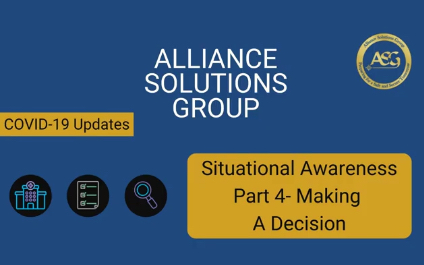This is part 4 of a 4-part series of videos from Alliance Solutions Group (ASG) regarding situational awareness and decision making during the COVID-19 global crisis. The information in this series is derived from our Crisis Leadership and Decision Making course that ASG developed for the Federal Emergency Management Agency (FEMA). This course has been delivered to over one thousand leaders across the United States over the past three years.
Stage 4 of situational awareness model is making a decision, using the information gained from levels 1-3 (i.e., Perception, Comprehension and Projection). As situational awareness improves, our perception of reality is more accurate and we are better informed to make higher quality decisions. In this video, Bob Campbell shares some essential elements to making good decisions about when and how to safely reopen businesses and government during the COVID-19 crisis.
Considerations for making a decision.
When we make decisions, we need to have some understanding of the (1) impact of that decision, (2) how long it will take to implement the decision and (3) whether we will achieve the effect we intend given that time to implement. We are constantly making decisions whether we realize it or not. In fact, “No decision” is a decision, so failing to make a partially good decision in a timely manner can result in negative outcomes. For example, during a hurricane evacuation, the time it takes to fully evacuate an area determines the decision point since a decision after this point will potentially leave more people at risk. During the COVID-19 crisis, there are multiple, interdependent decisions which need to be made. Each decision will have a primary impact with secondary and tertiary effects. It is important to realize that decisions still need to be made, and they will be imperfect. The goal is for a decision to be good enough to achieve more positive and less negative outcomes than the alternatives would have.
Decision timeliness and quality.
Decision timeliness is affected by the desire to obtain enough information so that the decision maker can make the best decision. However, obtaining all of the information desired to make a perfect decision is not likely attained. Even making the best decision, requires a sufficient amount of information from which the best decision can be made. But more likely, decision makers are under time pressure to make a good enough decision achieves the outcomes desired based on minimally sufficient information. Beware that delaying a decision in an attempt to attain the desired decision quality, as decision makers may result in paralysis by analysis, ultimately resulting in a poor decision.
Defining the Decision.
Decision makers need to define the decision in terms of the problem. This becomes very challenging in a complex environment, where a series of decisions are interdependent and affect multiple competing outcomes. For example, a decision to lock down is a great decision from a public health and disease prevention perspective, but not so from an economic perspective. Therefore, its critically important to carefully define the problem statement and the decisions that are needed. Defining a decision making process such as the data quality objective method may assist decision makers in objective decision making.
Formulating Multiple Courses of Action.
Decision makers should leverage the expertise of those reporting to them (especially if there is diversity in their areas of expertise) by having these experts develop courses of action, or alternatives. By having several high-quality alternatives, developed by experts in various disciplines, decision quality increases. It also provides the decision maker with the possibility of re-organizing or incorporating elements of each alternative into their decision.
Empirical Creativity.
While listening to science and evidence, decision makers should utilize the entirety of their brain— to include intuition, experience, and understanding those affected— and not limit decisions to only conventional wisdom, what has been proven or large establishments. We need to recognize that in uncertain circumstances, the reliable and proven institutions which thrive under certainty may not have the proven solutions needed to thrive through uncertainty and turbulent times. Some circumstances have not been studied and documented to the degree desired to produce high-quality, reliable information, so professional judgment plays a significant role in evaluating evidence within unique contexts.
If you are looking for assistance in navigating critical decisions about reopening, recovery, or the phased approach to protecting worker health and safety, ASG is here to help. We have been partnering with clients to prepare for, mitigate, respond to and recover from pandemics and other crises over the last 15 years. To learn more about how ASG could support your organization during this time, visit www.asg-inc.org or call 757-223-7233.
Don't worry, no spam here!
Keep up to date with the latest trends, best practices and innovations in the Emergency Management and Environmental, Health and Safety sectors.

